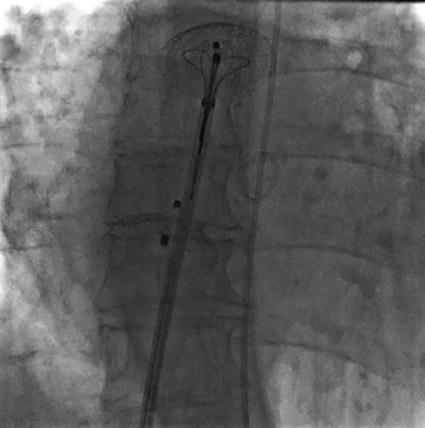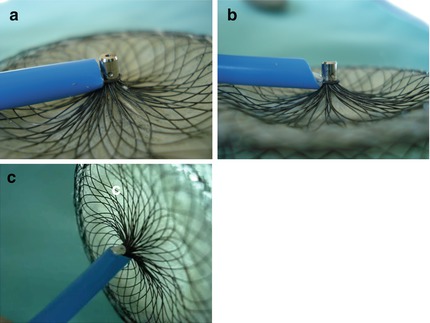Fig. 41.1
A multiple coaxial system, formed by a snare, a guiding catheter, and a large valved sheath. The maneuverability and orientation of a guiding catheter to direct the snare are coupled with the resistance and dimension of the sheath. A coaxial system also provides extra support to retrieve large devices
The most commonly selected retrieval device for an occluder is a snare catheter. Single-loop catheters are often used, but multiple-loop snares are excellent options, increasing the probability of capture (Fig. 41.2). The target is the device hub or attachment pin. Capturing the central part (stent) of an atrial occluder device with a snare will make it impossible to retrieve into a sheath.


Fig. 41.2
A multiple-loop snare retrieving a large Amplatzer device embolized into the left atrium. The multiple loops increase the probability of capturing and when used on a frontal approach, as shown in this figure, has a self-centering mechanism
The sheath selected for retrieval of an occluder device should be at least 2 Fr larger than the size of the original delivery sheath. When retrieving large atrial septal defect occluders, it can be useful to bevel the tip of the sheath at 30–40°, before introducing and advancing the system. The beveling technique is generally only applicable to non-armored sheaths such as the Cook Mullins Check-Flo. The main purpose of beveling is to provide a wider profile of the sheath to retrieve the snared hub of a large device. The best alignment for pulling the snared device into the beveled sheath is obtained by rotating the sheath or the snared device, so that the free end of the snared hub is aligned with the most proximal part of the beveled tip (Fig. 41.3). A beveled tip is sharp and so can potentially cause damage to the vascular and cardiac structures, so care must be taken when advancing the sheath without the protection of a dilator or a coaxial catheter.


Fig. 41.3
Capture of the hub of a large Amplatzer device. Retrieval into the sheath is not possible as the hub is long and perpendicular to the sheath (a). Beveling the tip of the sheath (b) allows for hub retrieval into the sheath (c), as this increases the sheath extremity profile
In some cases, it is useful to position a super stiff guidewire adjacent or beyond the embolized device, stabilizing the sheath during capture and reducing the risk of trauma. The guidewire should be removed after capture, before retrieval of the device into the sheath.
< div class='tao-gold-member'>
Only gold members can continue reading. Log In or Register to continue



